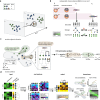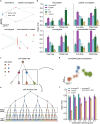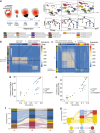Mapping lineage-traced cells across time points with moslin
- PMID: 39434128
- PMCID: PMC11492637
- DOI: 10.1186/s13059-024-03422-4
Mapping lineage-traced cells across time points with moslin
Abstract
Simultaneous profiling of single-cell gene expression and lineage history holds enormous potential for studying cellular decision-making. Recent computational approaches combine both modalities into cellular trajectories; however, they cannot make use of all available lineage information in destructive time-series experiments. Here, we present moslin, a Gromov-Wasserstein-based model to couple cellular profiles across time points based on lineage and gene expression information. We validate our approach in simulations and demonstrate on Caenorhabditis elegans embryonic development how moslin predicts fate probabilities and putative decision driver genes. Finally, we use moslin to delineate lineage relationships among transiently activated fibroblast states during zebrafish heart regeneration.
Keywords: Cellular dynamics; Fate decisions; Lineage tracing; Optimal transport; Regeneration.
© 2024. The Author(s).
Conflict of interest statement
F.J.T. consults for Immunai Inc., Singularity Bio B.V., CytoReason Ltd, Cellarity, and Omniscope Ltd, and has ownership interest in Dermagnostix GmbH and Cellarity. The remaining authors declare no competing interests.
Figures




References
-
- Guan J, et al. Chemical reprogramming of human somatic cells to pluripotent stem cells. Nature. 2022;605:325–31. - PubMed
MeSH terms
LinkOut - more resources
Full Text Sources

